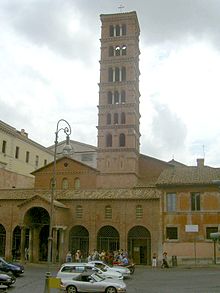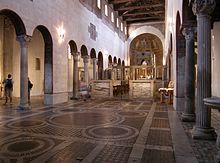Santa Maria in Cosmedin
This article needs additional citations for verification. (March 2016) |
| Basilica of Saint Mary in Cosmedin Basilica di Santa Maria in Cosmedin Template:It icon | |
|---|---|
 Medieval façade of Santa Maria in Cosmedin, with the bell tower. | |
| Religion | |
| Affiliation | Roman Catholic |
| Rite | Greek-Melkite Rite, Latin Rite |
| Ecclesiastical or organizational status | Minor basilica |
| Leadership | Msgr. Antonio Riccardo Menegaldo |
| Location | |
| Location | Rome, Italy |
| Geographic coordinates | 41°53′17″N 12°28′54″E / 41.88806°N 12.48167°E |
| Architecture | |
| Type | Church |
| Completed | 11th century |
| Specifications | |
| Direction of façade | Northwest |
| Length | 40 metres (130 ft) |
| Width | 20 metres (66 ft) |
| Width (nave) | 10 metres (33 ft) |
| Website | |
| Official Website | |
The Basilica of Saint Mary in Cosmedin (Italian: Basilica di Santa Maria in Cosmedin or de Schola Graeca) is a minor basilica church in Rome, Italy. It is located in the rione of Ripa.
History



The church was built in the 8th century, during the Byzantine Papacy, over the remains of the Templum Herculis Pompeiani in the Forum Boarium and of the Statio annonae, one of the food distribution centres of ancient Rome (another is to be found at the Theatre of Balbus). A deaconry was a place where charitable distributions were given to the poor, and it is appropriate that such an institution would have been built near or at a station of the Roman annona.
Since it was located near many Byzantine structures,[according to whom?] in 7th century this church was called de Schola Graeca, and a close street is still called della Greca. Greek monks escaping iconoclastic persecutions decorated the church around 782, when pope Adrian I promoted its reconstruction; the church was built with a nave and two aisles and a portico. Because of its beauty, the church received the adjective cosmedin (from Greek kosmidion), ornate. A sacristy and an oratory dedicated to St. Nicholas were added in the 9th century, by order of Pope Nicholas I, who also built a papal residence, but they were destroyed in the Sack of Rome (1084) by Robert Guiscard's Norman troops.
Santa Maria in Cosmedin was the titular church of Popes Gelasius II and Celestine III, as well as antipope Benedict XIII. Among the former titular cardinal deacons of the church was Reginald Pole, the last Roman Catholic Archbishop of Canterbury.
The inscriptions found in S. Maria in Cosmedin, a valuable source illustrating the history of the Basilica, have been collected and published by Vincenzo Forcella.[1]
A substantial restoration was accomplished in 1118–1124 under Alfanus, camerarius of Pope Callixtus II. After being acquired by Benedictines and a period of decay, in 1718 the church was refurbished in the Baroque style, particularly by a new façade, by Giuseppe Sardi.[2] The Baroque additions, however, were removed in the restoration of 1894–1899, together with the coat-of-arms of Pope Clement XI who had sponsored Sardi's work.
Architecture



In the portico of the church, on the north side, can be found La Bocca della Verità, an ancient sculpture thought to be a drain covering. A legend states that, if a person places his hand inside the mouth ("bocca") and then swears falsely, the mouth will close and sever the hand. There is no attested case of such an event taking place.
The church's bell tower is the tallest medieval belfry in Rome.
The current interior of S. Maria in Cosmedin has a nave with two aisles: these are divided by four pilasters and eighteen ancient columns. Built into the side walls, some of the old columns of the Statio Annonae are visible. Other fragments of the ancient building can be seen in the crypt. Paintings from the 8th-12th centuries, in three layers, are preserved in the upper part of the nave and in the triumphal arch. The church has a very fine Cosmatesque pavement. The schola cantorum is from the 13th century, while the main altar is a red granite piece from 1123. The Easter candelabrum is also from the 13th century.
The sacristy houses a precious 8th-century mosaic fragment brought here from the Old St. Peter's Basilica. Of the 18th-century restoration, the Crucifix Chapel and the Baptistry can be seen today.
In a side altar on the left of the church is kept the flower crowned skull attributed to St Valentine.
Modern Celebrity
A scene from the 1953 romantic comedy movie Roman Holiday was filmed in Santa Maria in Cosmedin. In the scene, "Joe" played by Gregory Peck shocks the "Anya/Princess Ann" played by Audrey Hepburn by pretending to lose his hand in the Bocca della Verità.[3]
References
- ^ V. Forcella, Inscrizioni delle chese e d' altre edifici di Roma, dal secolo XI fino al secolo XVI Volume IV (Roma: Fratelli Bencini, 1874), pp. 301-327.
- ^ Nina A. Mallory, Roman Rococo Architecture from Clement XI to Benedict XIV (1700–1758) ( New York: Garland Publishing, 1977), p. 54.
- ^ O'Connor, Joanne. "On location: Roman Holiday". Financial Times.
Bibliography
- Giovanni Mario Crescimbeni, Stato della basilica diaconale, collegiate, e parrocchiale di S. Maria in Cosmedin di Roma (Roma: Antonio de' Rossi 1719).
- G. B. Giovenale, La Basilica di S. Maria in Cosmedin (Roma: P. Sansaini, 1927) [Volume 2 of Monografie sulle chiese di Roma].
- Richard Krautheimer, Corpus basilicarum christianarum Romae. The early Christian basilicas of Rome (IV-IX cent.). (Roma: Pontificio Istituto de archeologia cristiana, 1937) [Volume 2 of Monumenti dell'antichità Cristiana].
- Federico Gizzi, Le chiese medievali di Roma, Newton Compton.[full citation needed]
- Elio Fox, Santa Maria in Cosmedin (Trento, Italy: Eurographik, 1969).
- Gemma Fusciello, Santa Maria in Cosmedin a Roma (Roma: Edizioni Quasar, 2011).
External links
- Webb, Matilda (2001). "Santa Maria in Cosmedin". The Churches and Catacombs of Early Christian Rome. Brighton: Sussex Academic Press. pp. 175–177. ISBN 1-902210-58-1.
- "S. Maria in Cosmedin", in Mariano Armellini, Le chiese di Roma dal secolo IV al XIX.[full citation needed]
- Federico Gizzi, Le chiese medievali di Roma, Newton Compton.[full citation needed]

